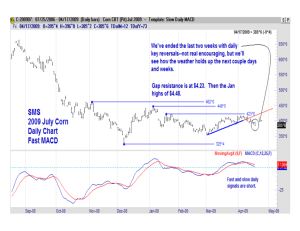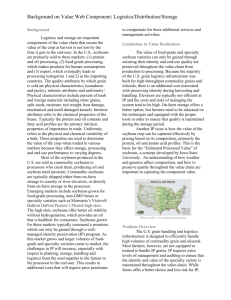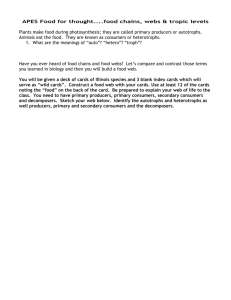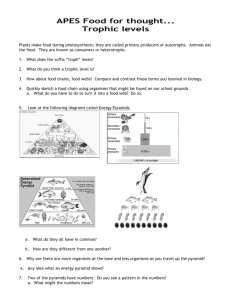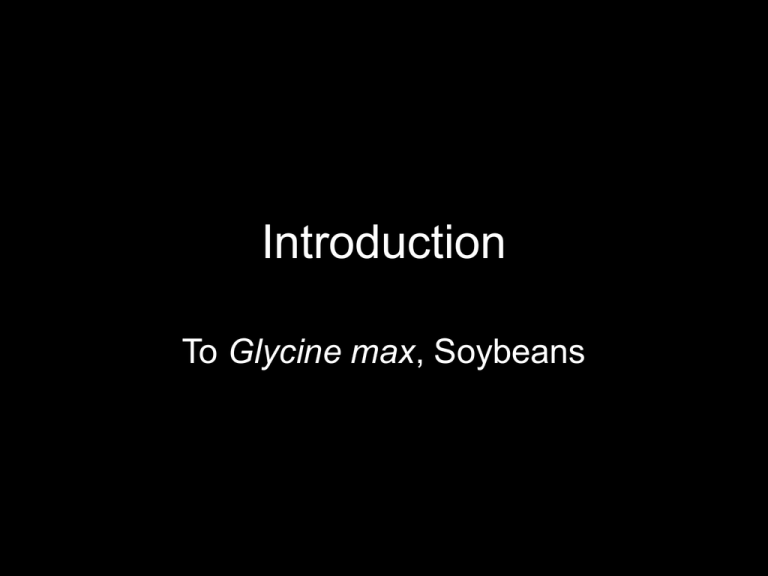
Introduction
To Glycine max, Soybeans
Importance of Soybeans
• Soybeans provide 75% of the
edible consumption of fats and
oils in the United States.
• US soybean exports were $8.9
billion in 2006. China was the
largest consumer of US grown
soybeans.
Source: www.soybeans.org/soystats.htm
Importance of Soybeans Cont.
• Soybeans are very prominent
ingredient in high protein feed
supplements for livestock.
• The economic importance of
soybeans reaches beyond
agriculture. It has importance
in many industrial, food, and
pharmaceutical products.
Source: www.NSRL.edu
Taxonomy of Soybeans
• Part of the Fabaceae
family and subfamily
Faboideae.
• Shares the same
subtribe, Glycininae, as
kudzu.
• Does not appear to have
a close relationship with
any other genus in the
subtribe.
Source:
www.aphis.usda.gov/brs/soybean.html
Morphology of Soybeans
• Soybeans are composed of a
nodulated root system that is
intermediate between a taproot
and fibrous root.
• The leaves of Glycine max are
alternate, and pinnately
trifoliate. Stipules are also
present.
• The flowers of the plant are a
zygomorphic condition called
papilionaceous.
• 2-4 seeds develop in pods.
Source: www.aphis.usda.gov
Reproduction in Soybeans
• Once the anther is
mature it is able to share
pollen with the stigma of
the same flower.
• This produces a very high
level of self-pollination. In
fact cross pollination
occurs less than 1% of
the time. Leading to pure
breeding homozygous
lines.
Source: www.aphis.usda.gov
Habitat of Soybeans
• Soybean cultivation is
typically most successful in
climates with hot summers.
• Optimum growing conditions
are in mean temperatures of
20ºC to 30ºC.
• Temperatures below 20ºC
and above 40ºC affect
growth significantly.
• Soybeans grown in a wide
variety of soils, but optimum
growth is in moist alluvial
soils.
Habitat of Soybeans
• Soybeans perform nitrogen fixation with
the help of symbiotic bacteria.
• For the best results farmers must inoculate
the seeds with the correct strain of
bacteria before planting.
• Seeds need a minimum ground
temperature of 55 to 60 degrees
Fahrenheit to germinate.
History of Soybeans
•Soybeans originated and were
first grown in northeastern
China.
•People in Asia have been
growing and using soybeans
for thousands of years.
•In 2853BC, Emperor ShengNung named five sacred
plants, the soybean was one of
the five.
•Soybeans were first brought to
the United States in the early
1800s as the ballast aboard a
ship.
•Soybeans were first planted
by farmers in the United States
in 1879 as animal feed.
History of Soybeans
• In 1904 the famous chemist
George Washington Carver
discovered the benefits of
rotating soybeans and cotton.
• In 1919 William Morse cofounded the American
Soybean Association.
• At this time there were only
twenty known varieties of
soybeans.
• In 1929 Morse went to China
and gathered more than
10,000 varieties for research.
History of Soybeans
• In the 1940’s soybean farming in the United States
gained popularity.
• World War II had devastated most of China’s soybean
fields and the farmers here produced what was needed.
• Since the 1950’s soybeans have accounted for 25 million
tons of animal feed each, no other animal feed comes
close.
• Currently, thirty-one states grow soybeans with the top
three producers being Illinois at 478 million bushels,
Iowa at 408 million, and Indiana at 274 million bushels
per year.
Harvesting Soybeans
• The bar on the front of the
combine cuts the entire
soybean plant, puts the seed
in the large tank in the top
center of the combine and
deposits the rest of the plant
back onto the soil. A combine
can harvest soybeans,
wheat, or corn from an area
the size of a football field in
three to five minutes.
Soybeans are harvested in
the fall and most often
followed by planting corn the
next spring.
Harvesting Soybeans
• Soybeans are then
deposited into semitrailer trucks and
hauled to processing
plant
Soy Uses
Soy Products
Research
• Research is being conducted on the isoflavone aglycone
derived from soybean germ which can be used to
prevent sudden deafness in humans by manifesting an
action that is effective in treating disease in humans.
• Research is also being conducted on the potential for
soy isoflavones in menopausal women. The promise of
soy isoflavones reducing chronic disease risk seems to
be non-uniform, with the most conclusive benefits
occurring in the prevention of cardiovascular diseases,
but other organ systems, such as skeletal and
reproductive tissues, may also benefit from the
consumption of soy and soy-derived products in
menopausal women.
Summary
• The United States is the principal world supplier of
soybeans (Jewell, 1988).
• Soybean, Glycine max (L.) Merr., combines in one crop
both the dominant world supply of edible vegetable oil,
and the dominant supply of high-protein feed
supplements for livestock.
• Other fractions and derivatives of the seed have
substantial economic importance in a wide range of
industrial, food, pharmaceutical, and agricultural
products (Smith and Huyser, 1987).
• Despite its non-popularity in the United States prior to
1940, the soybean has become one of the most
economically important plants grown in the United
States.
References
• Published 04/27/2000 © All Rights Reserved 2000,
2001, 2002. This Website created and maintained
by: TTS The John Deere (Combine and Tractor Trailer
Pictures).
• North Carolina Soybean Producers Board. United
Soybean Board
http://www.ncsoy.org/How_are_Soybeans_processed/ho
w_are_soybeans_processed_.htm (Soybean Processing
Picture)
• www.aphis.usda.gov
• www.soybeans.org/soystats.htm
• www.NSRL.edu




